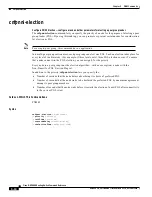
5-6
Cisco MGX 8850 Routing Switch Command Reference
Release 2.0, Part Number 78-10467-04 Rev C0, October 2001
Chapter 5
PNNI Commands
addpnni-node
addpnni-node
Add PNNI Node
—
creates a PNNI logical node.
The addpnni-node command creates an instance of a PNNI logical node on the switch. Use
addpnni-node to add a node in the following circumstances:
•
After you have removed a node from the topology by executing delpnni-node
•
After you clear the entire PNNI configuration from the switch by executing clrallcnf or clrcnf
For a single-peer network, you do not initially need to execute addpnni-node because the node comes
with a factory-set default. You can use cnfpnni-node to modify logical node values as needed.
Note
In the current software release, the switch supports only one PNNI logical node—the single peer
group setup.
To modify an existing PNNI node, use cnfpnni-node. For some of the node parameters, you first must
disable the node by executing cnfpnni-node -enable false. The following are applicable parameters:
•
The level is a number in the range 1–104 that shows the relative position of a PNNI logical node
within a multi-peer group. For a single peer group, only one level is possible.
•
The ATM address applies to the entire switch—only one is necessary for the switch regardless of
the release.
•
The PNNI node identifier (ID) defines the logical node on the switch. As the Syntax Description
explains, the node ID consists of numerous fields (see
Figure 5-1
).
•
A peer group identifier defines the nodes in a peer group within a network. Logical nodes on more
than one physical switch can belong to a peer group.
The sections that follow define the preceding fields. Refer to the description of cnfpnni-node for the
actual instructions to modify these items. Also, the Syntax Description section for addpnni-node
provides details about these parameters.
Constraints in the Current Release
For some of the addpnni-node parameters, only one value is allowed because the current release
supports only single-peer groups. The following list introduces these constraints, and the Syntax
Description provides more details.
•
You can configure only one PNNI logical node for each switch.
•
You must use the defaults for the -lowest, -complexNode, and -branchingRestricted parameters.
•
The index for a PNNI logical node on a switch is 1. You cannot configure the index—the system
generates it. The index appears in certain display commands, or the CLI prompts you to enter it.
(This local index differs from the network-wide index. See dsppnni-node-list for details.)
Address Field Descriptions
The addpnni-node parameters include two types of identifiers and an ATM address. These identifiers
and the ATM address have similar formats and overlapping information. The sections that follow
describe these parameters.
















































